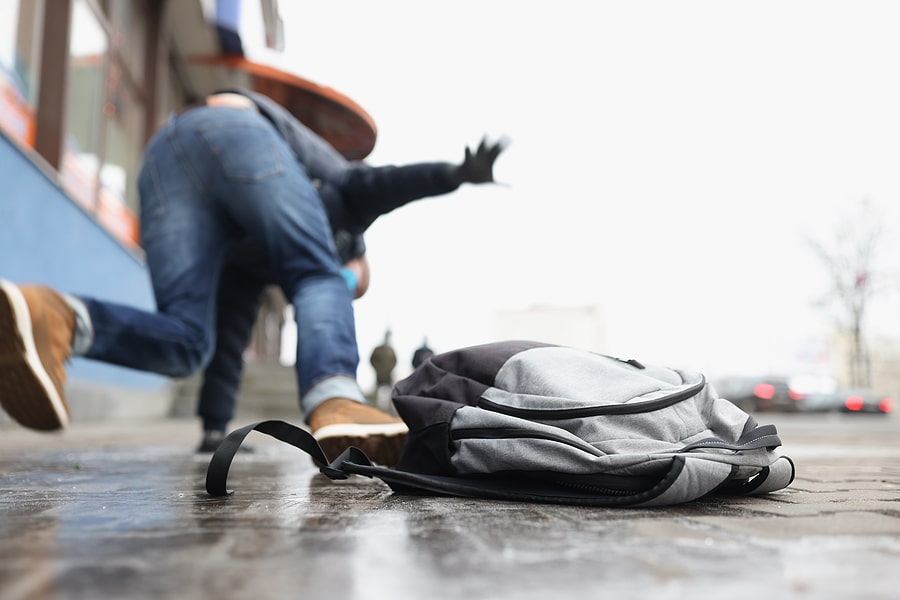Since most of us have been walking, we have always had to consider the possibility that we might lose our footing and fall. Kids seem built for this eventuality, and when they hit the ground, they bounce right up more often than not.
However, slip and fall injuries can cause serious injuries, especially in adults and older people. If you or a loved one have slipped and fallen, here are some things to consider as you research.
Determining liability of who is responsible for a slip and fall injury on ice and snow can seem complicated. However, it becomes clearer once you understand how a property owner must provide safe passage for visitors, customers, and other pedestrians. If you were injured on ice and snow, a slip and fall accident attorney can help you understand how and why the property owner is liable for your injuries.
Ice and Snow

The biggest problem with ice and snow is that they can create an almost frictionless surface depending on the temperature change. This is great at a hockey game, skiing, or other winter sports, but less so when you want to walk down a sidewalk or enter a store.
Ice is the solid state of water occurring with a drop in temperature below 32 degrees Fahrenheit. At these lower temperatures, the water molecules expand and crystalize, reducing the surface area in contact with other substances and making them “slippery.”
When ice melts, it can refreeze, creating a thin, frictionless layer of semi-frozen water or ice. When ice comes into contact with pavement or asphalt, it can be very difficult to see—but no less slippery. It is usually identified by its semi-reflective qualities, especially under artificial light. This black ice creates a thin layer that conforms to surfaces and turns an area that once had a lot of traction into a very slippery surface.
Since a property owner must maintain a safe environment for visitors, they must remove snow (which can quickly melt and refreeze, forming ice) and remediate icy spots with a de-icer such as salt or sand to prevent slipping and falling injuries. The de-icer raises the freezing point of water, preventing ice from forming at those threshold temperatures. This means the pavement retains its traction, and the water can drain away easier without forming black ice.
At the very least, they must mark slippery areas with warning signs until they make the area safe for passage. All of these things are up to the property owner, who may be liable for neglecting their duties to keep an area of passage safe for pedestrians.
Severity of injury
Slip and fall injuries are no laughing matter. Often, a slip leads to a very hard impact on a hard surface and can bruise, break bones, cause sprains and abrasions, and even traumatic brain injury. Shattered bones can lead to lost time at work, chronic pain, and even permanent disabilities. Abrasions can be extremely painful and result in infection if severe enough. The worst thing is that due diligence could have avoided all of these damages.
What Is a Traumatic Brain Injury?
A TBI results when the brain accelerates in the protective casing of the skull, suddenly stops, then moves again. The inertia resulting from this kind of impact can shear blood vessels, intracranial arteries, and damage other soft tissue within the brain. The resulting swelling can create severe damage due to the pressure exerted on the brain. Surgery may need to relieve the pressure, and infection, permanent brain damage, and even death may result.
Other slip and fall injuries
Though TBIs are a huge concern, slip and fall injuries encapsulate many other severe and painful ways you can be hurt.
Here are just a few others that are not uncommon and, more often than not, will require medical assistance.
- Whiplash: Like a TBI, whiplash can cause severe damage to the central nervous system, resulting in death and even paralysis. It results when the neck or spine moves in one direction and suddenly stops and changes direction. The stress exerted on the neck or spine can cause inflammation or even severing nerves in the spinal column. Symptoms may include numbness or tingling in extremities, neck swelling, or paralysis.
- Broken arms/legs: When slipping, a person’s reflexes usually cause them to try to break their fall somehow. Sticking out your arms or legs to stop the fall can break a wrist or ankle, which may be very severe in people with older bones or health problems.
- Broken pelvis: Older people, especially those with bone density problems such as osteoporosis, can be hurt severely with fractures to the hip or pelvis. These kinds of injuries may even become a death sentence for the elderly as they may come with other problems such as pneumonia, infections, or severe chronic pain.
- Sprains/torn ligaments: Age knows no limit to a torn ACL, MCL, or other ligaments. These extremely painful injuries may lead to long-term, debilitating pain.
- Death: A hard enough fall can kill, leaving grieving loved ones and others who might depend on the victim to sustain their quality of life. Someone must be held accountable for this kind of negligence, which has led to an unnecessary fatal injury.
Hospitalization
Whether it is just a fall with some bumps or bruises or something a lot more, a slip and fall injury can often mean an extended hospital stay, ambulance expenses, and even surgery. In more serious cases, hospitalization may not even be enough for grievous injuries resulting in death.
From the initial ambulance ride to hospital stays to surgeries and rehabilitation, the process can cost thousands of dollars. During your recovery, an attorney can take a lot of the stress off your shoulders when investigating what happened, communicating with police and first responders, and negotiating with insurance companies.
Other consequences
A slip and fall injury, especially one which requires surgery and a hospital stay, can lead to other long-term problems. That brief moment which was no fault of your own starts a domino effect that can lead to years of pain and suffering.
You might miss time from work due to recovery, which can jeopardize your employment and livelihood. If you suffer from a head injury, you might have cognitive disabilities resulting from the fall and may even need to change vocations or be trained for another occupation.
A bad enough injury can leave you with a permanent physical disability, which you may have to manage with medication, physical therapy, and subsequent surgeries further down the road. The psychological impacts might also be long-term, requiring therapy and medication due to PTSD. Meanwhile, the medical bills will continue to stack up, and your way of life has forever changed.
A brief moment of neglect on the part of someone responsible for their property and the safety of their visitors could very well have changed your life forever.
Obligation to maintain a safe area
Property owners/proprietors must provide a safe area for their customers, patrons, and visitors. That includes removing slippery surfaces such as water, ice, or snow. Poor weather conditions can make parking lots a hazard, which is why properties with large parking lots are required to sand or salt their parking lots.
When people track water into a store from outside, it must be marked clearly as a hazardous area, and an employee must clean it up as soon as possible to prevent injuries. Not only is weather a concern, but in places such as grocery stores, wet products such as oil or jars with brine can leak or break on the floors, creating a slippery, glass-filled surface that is just waiting to cause an injury. Hazards created by the weather are no less dangerous and owners must handle them promptly and carefully.
When this doesn't happen, usually a business or government building cut corners on staff or the expense of applying ice melt.
Cutting corners to save a dollar shows negligence in keeping an area safe, and you can hold proprietors accountable if they injure you without:
- Posting signs: A simple sign is the quickest way to indicate a hazard. Custodians must put up signs whenever they mop floors or liquid spills might cause slip and fall injuries. It takes seconds to deploy a sign. Failure to do so shows a lack of concern for visitors or negligence to save costs on hiring enough staff or providing proper safety equipment.
- Prompt cleaning/remediation: In places where snow tracks inside, absorbent mats and entry areas may also become slippery due to melting snow and ice. Readable signs must properly indicate these areas, and the area must be mopped or cleaned thoroughly. Otherwise, visitors to the building run a very high risk of slipping and falling on wet tile flooring.
- Snow/ice removal: After a snowfall, the proprietor's responsibility is to remove the snow to provide access to the public and customers. Depending on the city or county, they may need to remove it down to the pavement by a specific deadline. Otherwise, warming will create freezing and refreezing.
- De-icer/traction: In the wintertime, snowfall can descend quickly upon an area, leaving it a soupy, icy mess. The freeze and thaw of snow create ice, in some cases, black ice, which is very hard to notice yet is incredibly slippery. They must remove snow and ice as soon as possible, but this will not fix the problem. Applying a chemical de-icer or ice-melting sand to provide traction and get rid of the ice will make the area much safer in places such as sidewalks, parking lots, and even streets for people.
- Closing off an area: If they cannot immediately make an area safe, a proprietor must close off the area to prevent injury pending, remediation, ice removal, or the placement of warning signs.
What do I do if I am injured?
If you are researching this after an accident, the first point might be moot, but hopefully, the rest will give you a good road map for what to do next.
- If a slip and fall on ice and snow injured you, get help. Because of the severity of your injuries, call EMS or go to a doctor.
- Document everything you can. Since many people use smartphones, you can use yours as a tool to take pictures of the accident scene and gather information such as first responders’ contact information and any other details of the accident.
- Contact an attorney. Even a consultation can give you a better idea of how to proceed in the next steps.
- Collect and keep all hospital records and bills regarding the accident, as they will give your attorney a good idea of what they need to calculate for a settlement, not only now but in case of future treatment and resulting consequences.
What should I do next?
If a property owner’s negligence regarding a hazardous surface injured you, you may recover compensation for medical bills, lost time at work, and pain and suffering. If you are not already Google searching “law offices near me,” you need to. An attorney can help protect your rights.
Navigating the court process on your own is exhausting and complex. Luckily, most attorneys work on contingency to fight for a settlement for a slip and fall case, you will have plenty of resources to get your compensation. Working through the system on your own can be confusing, frustrating, and a very long-drawn-out process without the help of an attorney.
Why contact an attorney?

An attorney can talk with you about how to best protect your rights and confer with insurance companies, law enforcement, and even the party responsible for your injury due to negligence. An attorney will work to protect your rights as well as fight to get you the compensation you deserve. Attorneys know the laws and are an excellent resource to help you navigate the legal system and insurance process.
Contact a personal injury attorney if you would like to learn more about what you can do to protect your rights and get your life back together after a slip and fall injury on snow or ice.
An attorney can explain your options and help determine who needs to be held liable. Thousands of people are hurt in slip and fall injuries on ice and snow every year. Many may not realize they can hold property owners liable for negligence.
A slip and fall accident attorney can help you understand the laws and pursue the compensation you need. Most importantly, a lawyer can shoulder the burden of pursuing justice while you focus on recovery.
